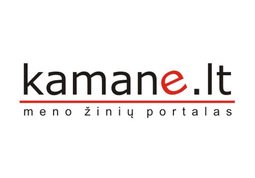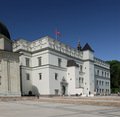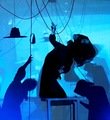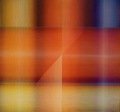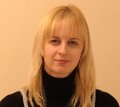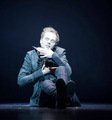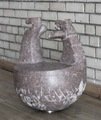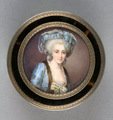The poetry of Adauktas Marcinkevičius' photographs 2016-11-14
Optimists and Skeptics is the title given to the exhibition by its curator Margarita Matulytė. The exhibition features photographs created over a five-year period. Looking at the exhibition through the curatorial lens it can be said that M. Matulytė succeeded to show Adauktas Marcinkevičius’ photographic interests quite widely and consistently - from practicing students to the portraits of the prominent artists of the time.
Rebuilding and restoring historical architecture (Part II) 2016-10-07
The continuation of the article series on rebuilding and restoring historical architecture. Trakai Castle restoration was not limited to the rebuilding of the brick walls - the research on the surviving frescoes required a more intense supervision. The sources indicate that Trakai Castle interior was a combination of different styles that were prevalent in the territory of the Grand Duchy of Lithuania.
Neemija Arbit Blatas: Lithuanian shtetl in Paris 2016-09-26
Almost all the Litvak artists of the first half of the 20th century who started their life in soon to be or already independent Lithuania, later immigrated to Paris, France. It is impossible to understand the phenomenon they had created there without knowing about the Litvak shtetl tradition.
Andrius Pukis about injecting Kaunas with contemporary art 2016-09-22
I met the sculptor, founder and a curator of POST gallery Andrius Pukis in Laisvės Avenue, when the strong August wind was whipping our hair. Gallery's three-year anniversary was only a couple of days away. "During those years we had so many different images, so we decided to leave the walls empty - instead of an exhibition - and fill the place with a lot of smoke," Andrius explained.
Starting Points at the Kaunas Chamber Theatre 2016-09-22
Festival Starting Point debuted at the Kaunas Chamber Theatre on September 7th-9th. The festival theme is story - how the narrative is created here and now. Stories, problems and solutions to them in the plays were presented by Vytautas Magnus University performing arts students, KTU Theatre Studio, Valentinas Masalskis' acting course students and Apeiron Theatre.
Faustas Latėnas, "Lithuania is undergoing a period of neglect" 2016-09-09
This year, Faustas Latėnas - cultural figure, Prime Minister's adviser on cultural matters, and composer, who has won many important awards and continues to promote Lithuania's name abroad - is celebrating his 60th anniversary. The experience that the interviewed artist has accumulated is impressive, therefore, we could talk about anything, but the axis of this conversation will be the music compositions for drama theatre performances and a short, but significant time spent in Kaunas.
The city pulsating in photographer Milda Kiaušaitė's veins 2016-09-02
"I live and work among people of culture who surround me since childhood, thus, you could say, I have created at least a some kind of oasis to shield me from political madness," says photographer Milda Kiaušaitė who is currently working as a secretary at the Kaunas branch of the Lithuanian Writers' Association. We are talking about the city, art, film cameras, protests, kitsch, photographs frozen in the memory and today.
Sometimes painting occurs without a brush 2016-08-24
As far as I remember, Eugenijus Varkulevičius-Varkalis was always traveling - with words, on foot or mystically painting (mystically, as it is unlikely that he uses the brush as often as other painters). All his oral narratives revolve around the road. And they started a long time ago, probably, during the childhood years, when he would model cities, towns or battle fields out of plasticine, in detail, to the "very last tile." The imagined world later on moved to the West, where he went in order to return back home.
Marija Djačenko, "Time to open the windows and clear the air" 2016-08-17
I remember Marija Djačenko from a time when many knew her as the young writer who had published a collection of short stories You Agree (Sutinki, 2005) while still studying in high school. Later on Marija left for England and appeared again in the literary context after 8 years when she published a book of short stories Full of Grace (Malonės pilnoji). A new literary project initiated by Marija came to life recently: charlesmethugo.com; it has become a pretext to start a conversation about memories, Europe, books and ideas.
Like an ox’s lick 2016-08-12
Essay today is prone to ease and diffusion of genres. The narrator in G. Bleizgys book Ox (Jautis, Vilnius: Lietuvos rašytojų sąjungos leidykla, 2016.) is able to reflect on a mother's death in one paragraph and to interpret Arnas Ališauskas' poem in the other. However, such choice does not prevent the reader from following the lines of the text and draws one into poetically and sensitively reflected authentic events as well as existential ponderings about life, death and continuity.
Berlin contemporary art biennial resonances 2016-08-08
The 9th Berlin Biennial - one of the most famous European contemporary art exhibitions - this year is taking place from June to September. It seems that we visit it less than the popular Venice biennial, Documenta in Kassel or Manifesto which constantly changes its location. After all, it is quite paradoxical: Berlin is not that far from Lithuania and the biennial project organized there is as good as the mentioned exhibitions, both with its size and the artistic intrigue.
Painter Agnė Liškauskienė, "The condition for creation is racing against time" 2016-08-04
Artist Agnė Liškauskienė draws the motifs for her canvases - free from literary narrations or social contexts - from the surrounding nature. She subtly abstracts the objects and phenomena met in reality to a conceptual sign or simply a color field, turning their identification into a very difficult task. Often, the only thing that helps overcome it, is the title of the work.
Kaunas Central bookstore is waiting for changes 2016-08-01
Heated debates sparked this spring on the future of the long-existing Kaunas Central bookstore. The concerned part of society was frightened that the bookstore will be destroyed after the planned privatization, just like other public places. While this story is full of political issues, I will try to distance myself from them and to look at the problem from the cultural heritage point of view.
In memoriam to Romas Juškelis who lived and created freely 2016-07-14
“He does not strive for glory and lives in his own rhythm”, the colleague Alvydas Vaitkevičius told about Kaunas photographer Romas Juškelis (1946–2016) about ten years ago. As the author visited R. Juškelis’ studio last summer, it seemed that the flow of work and life was similarly independent and would never change. Now, a year after this meeting, we speak about the photographer in the past tense already.
Vilija Grigaitytė, "I cannot stand lying on the stage" 2016-06-22
Vilija Grigaitytė is a Kaunas State Drama Theatre actress and a translator who was awarded this year with a Golden Stage Cross and Fortūna statuette for the supporting role of sister Veronica who sacrificed her life for the welfare of her brother in a play Woodman directed by the Latvian director Valters Silis. Artist has won a number of awards earlier. Her roles are characterized by the deep sense of the character and a desire to provide each of the role with individuality and originality.
The fantasy of the future 2016-06-21
Since many works featured at the exhibition Notes of Tomorrow show the situations of consciously shaped looking but not seeing and not noticing (or seeing obscure forms) a relevant question comes up - did something that is portrayed as a strange vision exist at all? Can its (non) existence ever be repeated?
Kaunas Jazz 2016 spring sounds. The second letter 2016-05-10
Festival Kaunas Jazz 2016 at the Vilnius Congress Hall was closed by an Ethiopia-born Israeli Ester Rada - a younger generation jazz star, who became famous only several years ago. Without a doubt, this was the best and most memorable concert of this year's festival.
Kaunas Jazz 2016. First (secret) letter 2016-05-06
Kaunas Jazz festival is perhaps the only festival that can be felt by all sympathetic to this (or not necessarily) genre of music. The festival features many different kinds of music and if some people start questioning whether it is jazz or not really, the answer according to Bobby McFerrin (the star of the 21st Kaunas Jazz) would be only one - "Don't worry." Let's relax and look for the jazz inside us.
Almost all of Alfonsas Andriuškevičius 2016-05-02
What I find interesting in the Lithuanian literary history are the people who write without having a philological education, for example: graphic artist Jurga Ivanauskaitė, art critic Kristina Sabaliauskaitė, physicist Ričardas Gavelis or philosopher Dalia Staponkutė. Such writers have a distinct way of understanding literature. Art critic Alfonsas Andriuškevičius can also be put next to the authors without philological education.
Art spells 2016-04-22
April is probably the busiest month in galleries and museums. Currently, upon visiting Kaunas galleries one can see jubilee, retrospective and quite magical phenomena; one can dive into meditation, look for light in the shadows, re-read the fairy tales, look at Kaunas from a different angle or get acquainted with art from another country.
Kaunas as a source of inspiration 2016-04-21
Theatre and film actor Dainius Gavenonis, Lithuanian National Culture and Art Prize winner has been previously awarded with Ministry of Culture prizes for his great roles; he had also received the Golden Stage Cross and Silver Crane among other awards. Actor, born and raised in Kaunas, shares the lively and sincere memories of his youth - one of the most important stages of life, full of fatal decisions.
Local spirit hovering in Kaunas 2016-04-08
The image of the city is shaped by a variety of symbols - such as architectural buildings or public city spaces: parks, cafes, restaurants, cultural sites. However, such material objects acquire meaning and a special atmosphere only because of the local population. In other words, these objects are provided with special meaning by genius loci.
Time forgotten in the notebooks - Jūratė Jarulytė's Northern Lithuania 2016-04-04
In 2015 artist Jūratė Jarulytė was developing a very personal, an almost autobiographical project Lithuanian North. The personal feeling of the project disintegrated in several layers - it is a geographical, emotional and an artistic experience.
Lithuanian light images. The antidote to loneliness 2016-04-01
Ignas Stanys and Vaiva Lanskoronskytė's photography exhibition Lithuanian light images was opened in Vilnius, at the Journalists' House (Jogailos str. 11) on the 1st of April. These are the artistic portrait series of the prominent Lithuanian personalities of culture. Most of the portrait series are accompanied by short photo stories - sound slides, developed from the portrait photographs and conversation fragments.
Conversation about French literature - between the classics and variegated ephemeral butterflies 2016-03-30
March, throughout the world is known as a month of Francophony. French culture has been pulling and attracting Lithuanians since the interwar period, when Kaunas - the Provisional Capital - was developing and had an ambition of becoming little Paris. We invited translator Jonė Ramunytė to talk about France from the Lithuanian perspective. She has been translating French literature into Lithuanian language for over two decades and is a true Francophone.



